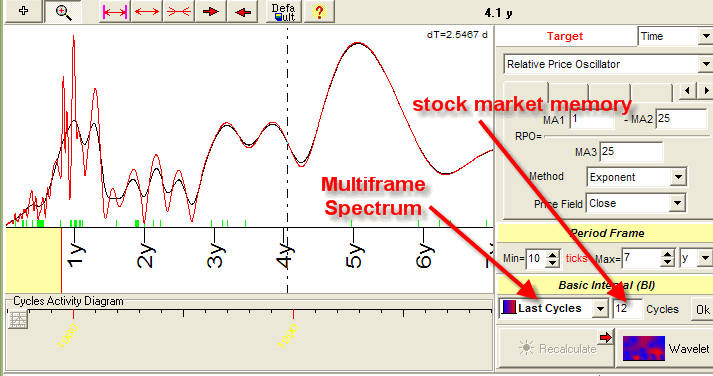
Multiframe Technology
notes for internal usage
In general, the idea of this technology is very simple: use the short length price history to reveal short term cycles, while use more price points for longer term cycles.
As an example, to calculate the 30-days cycle, we use 30*12=360 days of price history before Learning Border Cursor (LBC), while calculating the 1-year cycle, we use 12 years of price history. This idea is pretty logical - to reveal the short term cycles (like 10-days cycle), we use the latest price data only (before LBC), as the impact of these price bars is much more relevant for the future price movements than some price history 20 years ago. More data will be confusing. To reveal the long term cycles, the price data enough for short term cycles must be expanded - otherwise there will be not enough information to reveal the impact of these long term cycles on the market. And it was up to the user to decide what data are necessary for the analysis. Multiframe technology provides this task automatically. Due to complicated math methods and techniques applied in Timing Solution, the program itself analyzes data and suggests the time frame enough for the cycle's research. Moreover, using the same data, the program automatically selects different time frames for different cycles.
We do it through the Spectrum module. To apply the multiframe algorithm, set these parameters:

One parameter is very important here: stock market memory; it points out how much price history we use to understand the cycle's impact in respect to this cycle's period.
In our example, it is set to 12; this means that, while exploring the impact of 10-days cycle on the market, the program uses 10 days *12=120 days of price history.
This approach causes one effect - the view of spectrum diagram strongly depends on the position of Learning Border Cursor. It is especially important for short length cycles.
This approach is more sensitive to the recent price history, it reveals the cycles that have begun to impact the stock market just recently.
Using the analogy with a royal family member, we can say that the stock market memory corresponds to the memory of the royal person about her/his favorites (i.e. cycles). Some favorite may have the royalty's attention for a week (i.e., short cycles), while another one may be of some interest for years (long term cycles). The memory of the royal person is proportional to the importance/interest/appeal of the favorite. We are not modeling the mood of this person regarding her/his favorites (i.e. cycles). We just ask who is in favor now, i.e. what cycle is the most influential for the last few months. And we make a forecast based on this cycle. Periodically, we update our information regarding new favorites and make new forecasts as well.
The multiframe algorithm is applied in Astronomical module (Composite) as well. Set it this way:
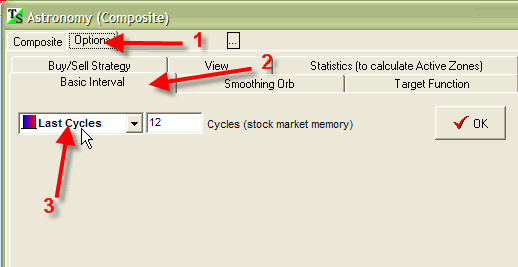
Thus, to calculate the Moon's 28-days cycle, we use 28*12= 336 last days, while to reveal the annual cycle we use 12 years history.
The mulltiframe technology is represented in all modules of the program. In the Neural Net module, you can set the multiframe training regime:
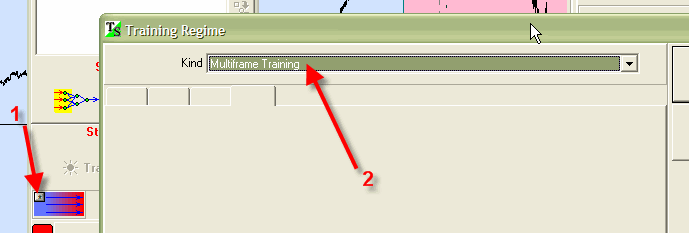
During the training process, the program pays more attention to the latest short term events (all events). There is a special way to set the stock market memory parameters in respect to these events. Do these settings in the "Options" window:
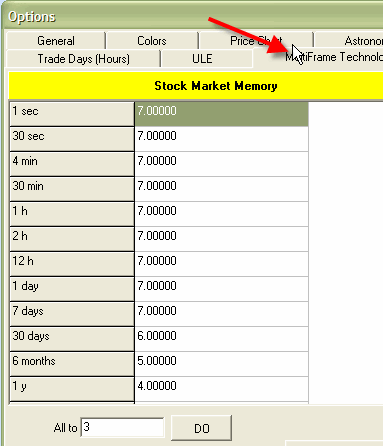
Recently we have developed the special module that allows to reveal the astronomical cycles very fast:
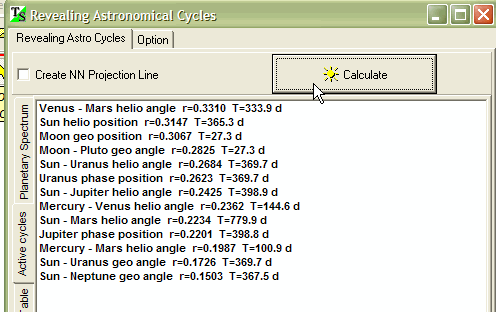
You can set the multiframe algorithm there as well:
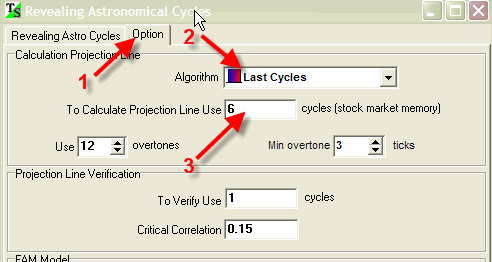
With the multiframe technology, you need to vary one parameter only - stock market memory. It is easier in comparison to attempts to set different length of training interval.
This is an experimental technique, and I am not quite sure yet what is the value of stock market memory. My preliminary thoughts regarding stock market memory are:
a) it should be at least 3.0 (2.0 is minimum)
b) "12" looks like too big value (our royal person does not remember anybody so long).
c) the optimum value is somewhere between a) and b).
The question regarding the stock market memory is the most important for me now. This technology is totally "terra incognita", and we must build a "digital fortress" to make this territory inhabitant. In other words, we need to conduct the extensive Back Testing to get answer on this question. This is what I do now.
Some information regarding this issue has been provided by Mark Juric, who told me about 4 as a value for stock market memory (to be exact, this information has been provided for autoregression model).
All existing Solutions are now transferred to multiframe regime, except the Dynamic model. For Dynamic model, the multiframe regime does not provide good results. For Dynamic model we use 4 years as a training interval.
August 6, 2005
Toronto
Canada